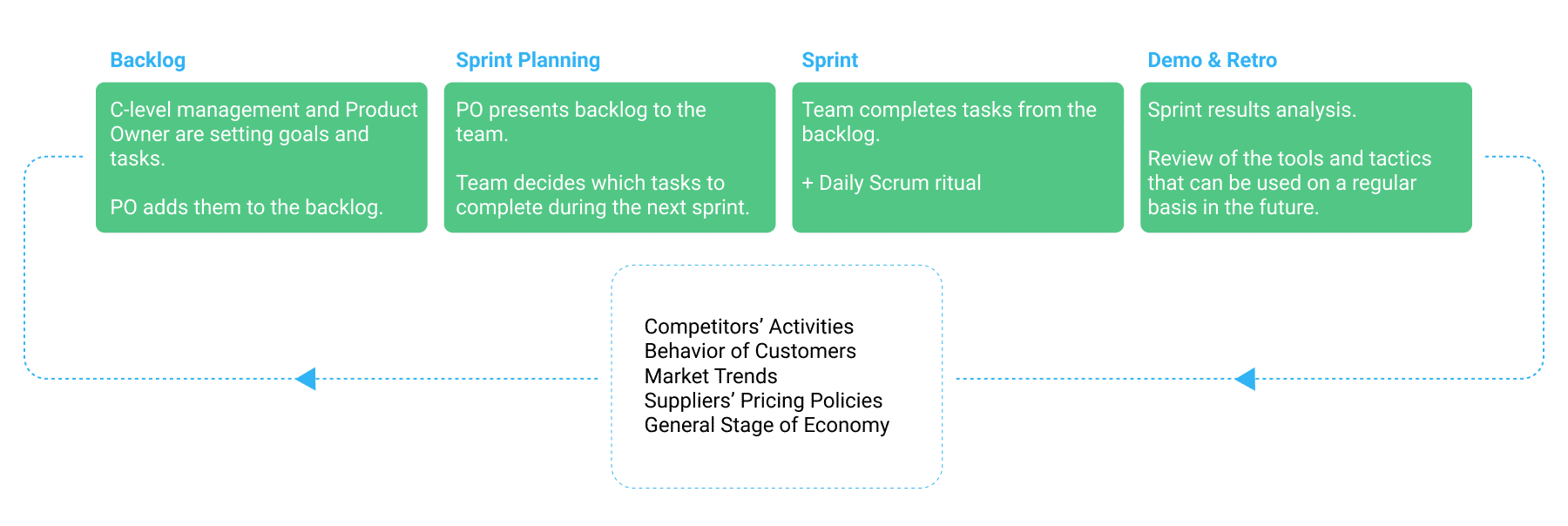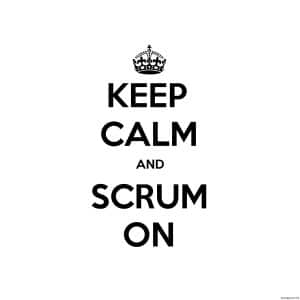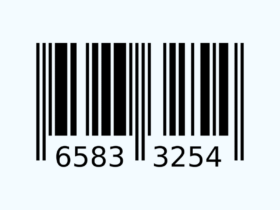The IT industry monopolized agility: Not many people know that agile methodology can, and needs to, be used in retail.
The Classical Retail Model
Today, retail works according to a classical layout:
The category manager receives information about the market such as how the buyer behaves, the actions of the competition, the policy of the supplier, the general state of the economy, and the trends, as well as about the business strategies of their own store in order to work with product categories such as the development of the category strategy and tactical steps, in order to the reach the set KPI. Additionally, every month, quarter, or half a year, the previous period is revised in order to figure out the effectiveness of the category strategy, tactical steps and the effectiveness of the manager. Depending on the results that were received, the plan is created for the next accounting period.

This kind of classical model, despite the fact that its effectiveness loses, still works. Especially for large retailers since their sales not only covered by the active marketing, but also by a sustainable, well-known brand.
Agile in Retail
The weak spots in the classical layout of work in retail are:
• the slow-paced reaction when it comes to change
• the inflexibility of the team when it comes to requests from the category manager (marketing, IT and other retailer teams has their own KPIs, and not ready to actively cooperate)
• complications with adapting to new methods and approaches for work.
These limitations led retailers to begin to adapt elements, and sometimes even full state-of-the-art frameworks of agile methodologies in their work, to quickly react to changes while remaining competitive.
Today, we’ll take a look at the most effective frameworks for the organization’s processes in retail, aka: Scrum.
Scrum for online stores
In the classical understanding of the word “scrum”, it’s a model that’s controlled by the development process and helps companies reach their goals within a specific period of time. At the same time, it will show the current program—whether it be a program, application, etc.—at every development iteration.
It’s these scrum principles that have been adopted by retail.
| Disclaimer: The transition to scrum after working in a classical retail model is a serious challenge for retailers. They’re required to master a new approach in project management, teach the team how to work in a new paradigm, and provide the technical tools for implementing quick changes. |
Despite all of the difficulties that arise during the transition into working in a new framework, it’s worth all of retailer’s efforts. This is because it helps them quickly adapt to omnichannel buyers who aren’t planning on waiting while a store adapts to changing prices and to consumers needs (read, the buyer who leaves for the other store).
How Does Scrum Work in Retail
It’s important to remember that scrum is the base where you need to adapt to the needs of every competing team. Down below, you will find rituals, rules, and artifacts that could be used as examples, but that need to be adapted to a specific retailer when in use.
The Scrum Roles in Retail
Due to the heterogeneity of the team of the online store the distribution of roles can vary from one retailer to another. We only distribute to those that our customers—retailers around the globe—have come in contact with.
Client. The client in this case is the top C-level management of the online store. They choose the goals that the business needs to reach and communicate with the Product Owner.
Product Owner (PO). Often times, this role is filled by the Category Manager or the head of the commerce department. They’re responsible for communication with the “client”, since they understand the team’s set goals and their strive to achieve those results. It’s the PO that is responsible for forming the backlog tasks for the team.
Scrum master (SM). The classical definition of a scrum master is a leader that serves, servant-leader. They are also known as a servant-leaders. In most cases, where online stores have introduced scrum, the analyst is best able to cope with this role. They’re the ones who help the team develop efficiency, provide quality statistics, and give quick feedback to implemented updates.
| Keep in mind: The size of the team should not be bigger than nine people, or else the efficiency will become inversely proportional to the number of people. |
Team. The team should consist of developers, marketers, category managers, and other team members such as partners, strategists, operational directors, and e-commerce managers. The structure needs to be based on the profit to the project. The task of a scrum master and project manager is to create a self-organized and multi functional team that reach their goals together.
Rituals (the work process)
If the roles in the scrum methodology does not change the processes of a company crucially, then scrum rituals completely redefining the essence of the interaction between people and teams.
Instead of long iterations per month/quarter/half-a-year, the team begins to operate in shorter spans of time, known as sprints. Sprints give the flexibility to regulate any changes in the market within the company. Typically, sprints last about one or two weeks, and less often, more, but never that a month. Sprints are the basis for work in the remaining rituals of scrum in retail.
As soon as the team mutually decides on the length of the sprint, they can transition into the other rituals of scrum.
• planning the sprint, for the distribution of tasks within the team
• the daily stand-up is when team summarize the day and get rid of blockers
• review the sprint to demonstrate the sprint results
• the retrospective for you experiences exchange from within the team
Examples of Scrum in Retail
Suppose that you, as a retailer, found a new competitor, who actively dumps in an attempt to gain market share. In the classical model, the correct answer to their appearance is to lower the prices on the KVI-position, or even on the KVI-category, which could potentially lead to the loss of the retailer.
The scrum methodology allows retailer to quickly figure out the competition (the analytic). During the sprint, it helps to come up with alternative ways to fight, as well as reduces prices (stocks, free delivery, gifts, offline activities, etc.), quickly test out different price tactics, respond to their results (the daily stand-up) and use the best practices on a regular basis (review and retrospective).

Within this framework the entire team clearly understands their responsibility for the final results and are interested in reaching the set goals.
The Disadvantages of Scrum for Retail
Regardless of all of the advantages of the agile methodology, the retailer need to apply a significant effort coming in from it. During the switching from classical retail model to scrum, in the first stage, efficiency may drop.
The most often reason of decline in efficiency is the rejection of new tools by the team. Even the simplest tool for organizing the work of a scrum team, a typical board or wall, will require some efforts to switch the team’s methodologies.
Probably the most well known online tool for working with scrum methodologies is Jira. Regardless of the fact that it was created by developers and for developers, it’s pretty flexible to use for a variety of processes. A popular alternative to Jira is Trello. This tool has a more user-friendly interface, and it has a free, basic version that works for teams of any sizes.
What’s not so obvious, is the important element in the methodology of scrum for retailers—the instruments that help retailer to:
• Receive quality information about the market quickly;
• Analyse of the competition influence on the retailer’s sales;
• Quickly change the price of products in just a few clicks;
• Analyse the impact of pricing strategies and rules on the target metrics: sales, turnover and margin.
If you don’t use such price tracking software, the introduction of scrum loses its purpose, since the retailer won’t be able to quickly react to changes on the market, set pricing rules, or analyse its efficiency.
As the saying goes, Keep Calm and Scrum On.





